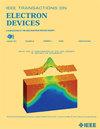单带和多带互补场效应管(cfet)中的应力:工艺流程的演变及其对驱动电流的影响
IF 3.2
2区 工程技术
Q2 ENGINEERING, ELECTRICAL & ELECTRONIC
引用次数: 0
摘要
预计在纳米片结构中的应变工程,包括互补场效应管(cfet),将是具有挑战性的使用传统的S/D外延方法。本工作通过耦合力学和器件模拟来研究cfet中的应变保留,为可扩展应变工程提供集成相关建议。模拟自对齐工艺流程,识别应力诱导步骤:1)S/D凹槽;2) Si ${}_{{0};{0}}$ Ge ${}_{{0};$ S/D外延;3)纳米带(NR)释放。预计最终器件在pMOS和nMOS通道中分别保持1.3 gpa(压缩)和+500 mpa(拉伸)应力。即使没有S/D工程,对于nMOS,由于牺牲层(SLs)传递的应变而产生拉伸通道应力,这也抵消了pMOS通道中的压应力。因此,SLs中的Ge%被认为是调节应力的关键因素,因为降低它可能会增强pMOS NRs中的压应力,而在nMOS/pMOS SLs中使用不同的Ge%可以实现独立的应力调制。此外,pMOS NRs中的应力传递预计依赖于S/D epi的基板锚定,从而将其限制在底部。预计残余应力不受背面加工的影响。通道应力也随着S/D体积的增加而增加,多功能区pMOS的压应力增加,尽管最上面的带状减少了15% - 20%。模拟传递特性估计(100)-和(110)-表面在高压应力($ $ 1$ GPa)下的驱动电流差异可以忽略不计,而(110)-表面在低压应力下仍然有利。所提出的模拟为在cfet中集成应变通道的技术选择提供了指导,并概述了实验验证的方向。本文章由计算机程序翻译,如有差异,请以英文原文为准。
Stress in Single- and Multiribbon Complementary FETs (CFETs): Evolution in Process Flow and Impact on Drive Current
It is anticipated that strain engineering in nanosheet architectures, including complementary FETs (CFETs), will be challenging using conventional S/D epitaxy methods. This work investigates strain retention in CFETs through coupled mechanical and device simulations, offering integration-relevant suggestions for scalable strain engineering. A self-aligned process flow was simulated to identify stress-inducing steps: 1) S/D recess; 2) Si ${}_{{0}.{4}}$ Ge ${}_{{0}.{6}}$ S/D epitaxy; and 3) nanoribbon (NR) release. The final device is projected to retain 1.3-GPa (compressive) and +500-MPa (tensile) stress in the pMOS and nMOS channel, respectively. Even without S/D engineering, for nMOS, tensile channel stress arises due to strain imparted by the sacrificial layers (SLs), which also counteracts compressive stress in the pMOS channel. Consequently, Ge% in SLs is identified as a critical knob for tuning stress, as lowering it may enhance compressive stress in pMOS NRs, while employing different Ge% for nMOS/pMOS SLs could enable independent stress modulation. Furthermore, stress transfer in pMOS NRs is projected to rely on substrate anchoring of the S/D epi, thereby confining them to the bottom. The retained stress is predicted to remain unaffected by backside processing. Channel stress is also observed to scale with S/D volume, with multiribbon pMOS featuring increased compressive stress, albeit with 15%20% reduction in topmost ribbons. Simulated transfer characteristics estimate negligible drive current differences between (100)- and (110)-surfaces at high compressive stress ( $\ge 1$ GPa), while (110) remains favorable under lower stress. The simulations presented provide insights to guide technological choices for integrating strained channels in CFETs and outlines directions for experimental validation.
求助全文
通过发布文献求助,成功后即可免费获取论文全文。
去求助
来源期刊

IEEE Transactions on Electron Devices
工程技术-工程:电子与电气
CiteScore
5.80
自引率
16.10%
发文量
937
审稿时长
3.8 months
期刊介绍:
IEEE Transactions on Electron Devices publishes original and significant contributions relating to the theory, modeling, design, performance and reliability of electron and ion integrated circuit devices and interconnects, involving insulators, metals, organic materials, micro-plasmas, semiconductors, quantum-effect structures, vacuum devices, and emerging materials with applications in bioelectronics, biomedical electronics, computation, communications, displays, microelectromechanics, imaging, micro-actuators, nanoelectronics, optoelectronics, photovoltaics, power ICs and micro-sensors. Tutorial and review papers on these subjects are also published and occasional special issues appear to present a collection of papers which treat particular areas in more depth and breadth.
 求助内容:
求助内容: 应助结果提醒方式:
应助结果提醒方式:


